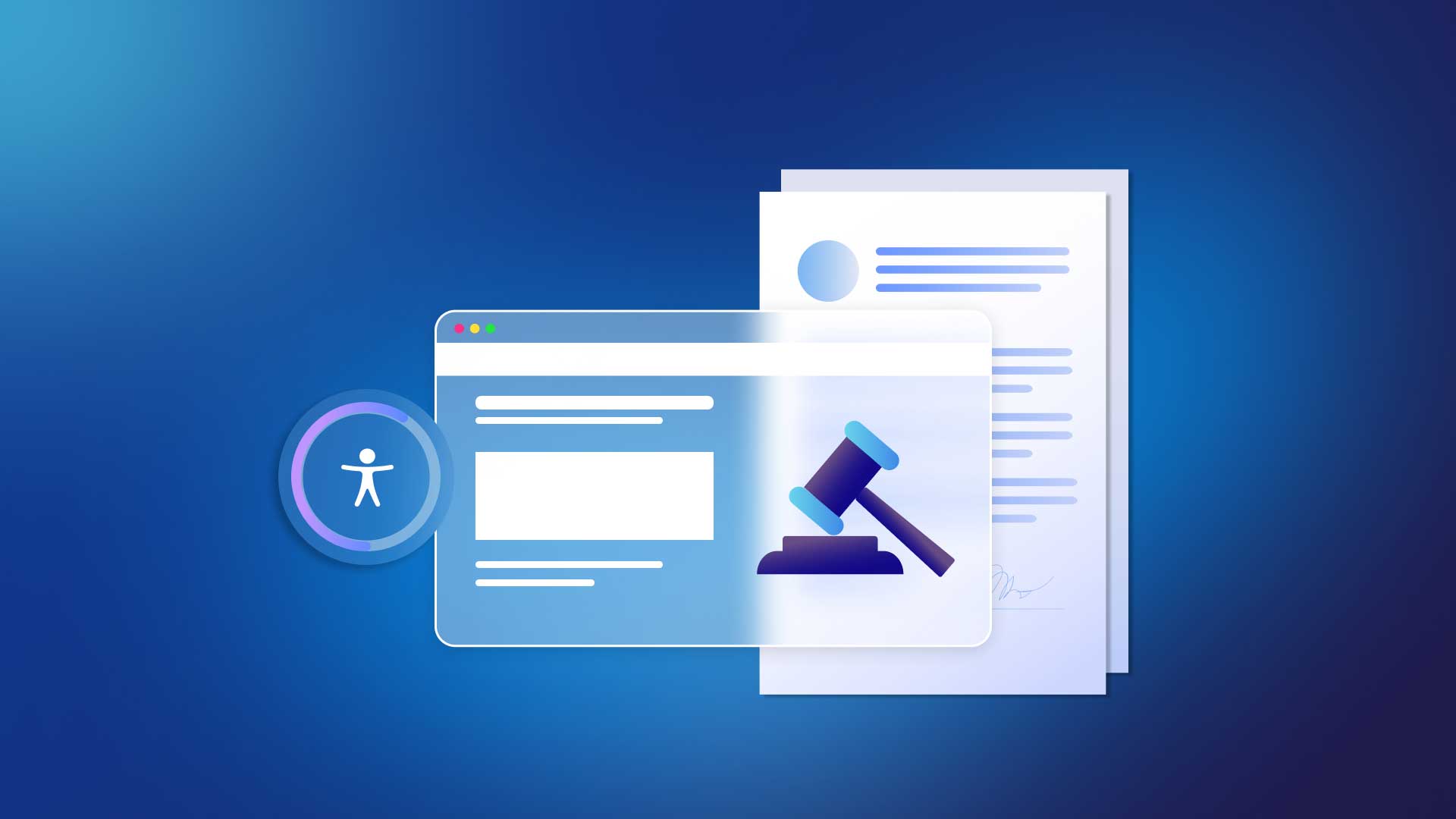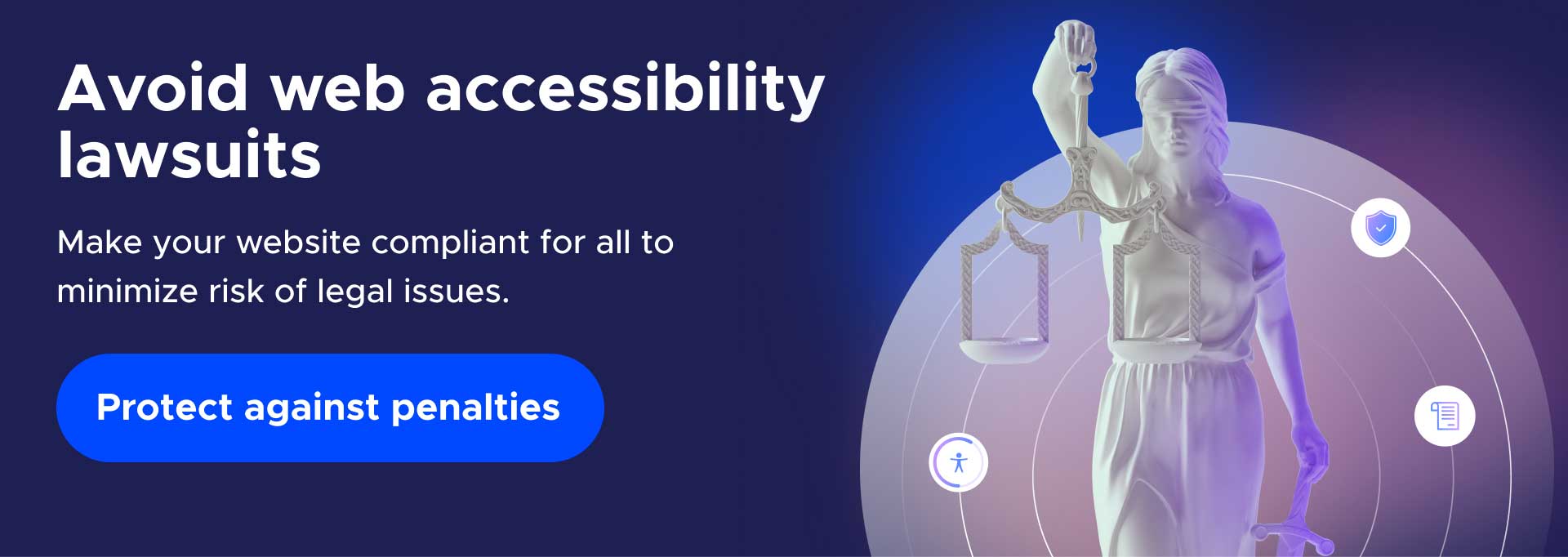ADA website compliance lawsuits 2025: A complete guide

When businesses fail to comply with the Americans with Disabilities Act (ADA), they not only sideline a significant portion of the population – people with disabilities – they expose themselves to substantial legal risks. This lack of compliance is sparking an increase in ADA website compliance lawsuits; it’s a trend that’s showing no signs of abating.
Beyond the ethical drive to be inclusive, there’s also a compelling legal and financial incentive. Addressing accessibility issues reduces the risk of costly litigation and can also broaden a customer base – a win-win scenario.
Despite these incentives, many businesses continue to struggle with compliance, leading to a growing number of legal challenges.
This blog will explain the implications of non-compliance with the ADA and how to navigate website accessibility legal cases. We’ll also provide best practices and strategies to help you avoid accessibility-related legal challenges.
The ADA website accessibility law: from origins to online
Many people are not fully aware of what the ADA requirements for websites and physical spaces cover. While it’s commonly associated with physical accommodations like ramps and curb cuts for wheelchair access, handrails and grab bars in restrooms, that’s only part of the picture.
The ADA also extends to online spaces, and the law is continuously evolving to encompass different aspects of the digital world. This expansion ensures that accessibility is covered both in physical locations and digital content and services. In fact, federal and state courts require that websites meet ADA accessibility standards, making compliance essential for all online platforms.
What does the ADA cover?
Generally, ADA is organized into three key areas:
1. Employment (Title I) – This section ensures that workplaces are accessible and equitable. It focuses on employment equality, helping people with disabilities secure and maintain employment just like anyone else.
2. Public Services (Title II) – This part deals with services provided by state and local governments. From public schools to transportation systems, it ensures that all government services are accessible to everyone.
3. Public Spaces (Title III) – This area applies to businesses and nonprofits that serve the public, like restaurants, stores, and cinemas. It mandates that these places are accessible, ensuring that everyone can participate in public life.
The facts and the figures: ADA compliance website lawsuits
Although there are many strategies businesses can take to avoid an ADA compliance website lawsuit, there have been some very high-profile legal issues that businesses of all types and sizes have faced. Here are some ADA website lawsuits statistics and facts that every business should be aware of:
- Record-breaking litigation in 2021: Nearly 11,452 web-accessibility cases filed in federal courts, marking a historic high of websites failing to meet ADA requirements.
- Sharp increase in legal actions: The surge to 4,605 web accessibility lawsuits in 2023, a nearly 42% increase from the previous year, illustrating the escalating enforcement of ADA Title III, governing public accommodations.
- Litigation without borders: Plaintiffs can launch website accessibility lawsuits from home, circumventing the need to physically visit a site.
- The simplicity of suing: The straightforward nature of identifying non-compliance online increases the frequency of lawsuits, emphasizing the urgent necessity for robust online compliance.
- Shifting legal grounds: Rapid changes in accessibility laws can leave businesses unexpectedly non-compliant and legally exposed.
- Strategic compliance is key: Adherence to ADA regulations offers the strongest shield against potential web accessibility lawsuits.
- New York – a legal hotbed: Nearly 75% of all web accessibility lawsuits occur in New York. Physical presence in the state is unnecessary; having customers there suffices for legal exposure.
What if you face an ADA lawsuit for website non-compliance?
Facing an ADA lawsuit for website non-compliance can be daunting, but there are steps you can take to navigate the situation. The first port of call is to immediately seek legal counsel with expertise in ADA compliance and digital accessibility. They can provide guidance on the legal process and help you understand your obligations and defenses. They will be able to support you throughout the legal process.
Here’s a step by step explanation of what actions to take should a plaintiff sue your business for running a non-compliant website:
1. A notice arrives
You get sued and receive details on your compliance violations. You may also learn what damages the plaintiff is seeking. Below, we go into further detail on the types of notifications and stages of web accessibility lawsuits to expect, along with the respective timeframes to address them.
2. Hire a lawyer
You’ll need a defense lawyer to prepare your legal strategy properly, which can be costly. Still, it’s necessary to find a lawyer who’s an expert in internet accessibility law and equal rights. Then, build a case and refute any charges against you in an ADA website lawsuit. The goal is to create a solid defense showing your website is accessible and compliant.
3. Go to trial
You likely need to go to trial once your lawyer prepares your defense, which can come with hefty fines. The penalty for not meeting accessibility standards can range from $50k to $100k. Remember that there are various steps you can take to verify whether the plaintiff is filing bogus claims, along with investigating whether they even attempted a purchase or your site. The best practices are outlined in detail below.
4. Make your case
While you may be correct, and your site is, in fact, accessible, you’ll need an expert witness to attest to that fact. If you are a reputable web developer, you may count as the expert, but if you’re not, get ready to pay. You’ll need to hire an impartial technical expert to witness your case who can provide a detailed technical review proving that your site is accessible and the claims of the website accessibility lawsuit may be bogus.
5. The outcome
Accessibility lawsuits are becoming more commonplace, and many businesses settle out of court to avoid a protracted, costly legal battle. It’s easy to understand why. Even if your site is compliant and you technically win the case, it’s not over. The plaintiff can appeal to higher courts, dragging the case out for years. And even if you win, recovering lawyer and court fees can be difficult.
Sometimes, the judge may award you damages for legal fees, but it may be in small sums over many years. If your site is proven noncompliant, things get even more expensive, as you’ll need to pay a fine at the judge’s discretion.
The bottom line?
Regardless of the outcome, facing a lawsuit can significantly drain your finances. The equation is straightforward but costly: Lawyers’ Fees + Lost Productivity + Technical Expert Witness Fees + Court Costs + Potential Fines = Substantial Expenses. This doesn’t even begin to consider the additional risks of negative publicity and the potential damage to your reputation.
Which businesses are vulnerable to website accessibility lawsuits?
No business is immune from being sued for failing to have a website that is accessible to everyone. Adhering to ADA requirements for website accessibility is essential to avoid such legal pitfalls.
All-sized companies risk penalties for an ADA violation lawsuit, and even the most prominent firms may need a better understanding of respective guidelines. It may seem obvious that companies with extensive web development teams would protect themselves against non-compliance, however they’re still being impacted by hefty fines.
An example of an ADA website lawsuit is Greyhound, who recently paid $300,000 for an ADA compliance lawsuit and the standard $75,000 civic penalty. The company only had 15 days to pay the $75,000 in civil penalties. Could your business afford that kind of fine in such a short space of time?
Greyhound’s penalties pale in comparison to other cases. Here are 2 more examples of ADA lawsuits taken against websites:
- National Federation of the Blind v. Target Corporation (2005)
The National Federation of the Blind (NFB) alerted Target Corporation in 2005 of their website’s inaccessibility to blind people and filed a lawsuit in 2006.
- National Association of the Deaf v. Harvard (2015)
The association alleged Harvard and MIT violated the ADA and Section 508 for not providing accurate and comprehensive video/audio captioning for online courses. The ruling ensures that university-sponsored web content is digitally accessible. Harvard paid $1,575,000 in attorneys’ costs and fees.here was a $6 million case against Target, in which the company also paid over $3.5 million in attorney’s fees for the National Federation of the Blind.
Violating the ADA can lead to enduring consequences. Rather than incurring fines and legal costs, why not proactively enhance your website’s accessibility and compliance? Use any settlements from website accessibility lawsuits as a learning opportunity to prioritize digital inclusivity. This approach will mitigate legal risks and demonstrate a commitment to providing equal access for all users. Why wait for potential legal action when you can win at accessibility by being inclusive from the start?
Why the WCAG: Building ADA compliance into websites
Businesses aiming to ensure their websites are ADA-compliant should adhere to the specifications of the Web Content Accessibility Guidelines (WCAG), formulated by the World Wide Web Consortium (W3C). Recognized globally, WCAG significantly influences web accessibility policies worldwide.
An overview of the WCAG guidelines:
These guidelines are structured according to four key principles:
- Perceivable: All users must be able to perceive the content through any of their senses.
- Operable: The user interface and navigational components must be functional and usable.
- Understandable: Both the information and the operation of the user interface should be easy to comprehend.
- Robust: The content should be sturdy enough to be interpreted by a broad range of user agents, including assistive technologies.
There are three levels of WCAG compliance: A, AA, and AAA. Level A is the most basic, Level AA meets more stringent requirements and is the standard most referred to in accessibility legislation globally, and Level AAA is the most rigorous.
Meeting WCAG Level AA conformance is typically sufficient to prevent accessibility litigation. By implementing these guidelines, businesses can enhance the accessibility and user-friendliness of their websites, promoting inclusivity for all web users. So, what strategies can you use to boost web accessibility and sidestep potential ADA lawsuits?
What are ADA requirements for websites?
Building an ADA-compliant website guarantees that users of all abilities can effortlessly navigate, comprehend, and engage with your content. Below are a few ADA requirements for websites that can help you avoid a lawsuit:
- Missing image alt text: Alt text describes visual content critical for accommodating screen readers. The highly publicized Robles v. Domino’s Pizza, LLC, CA, cites this ADA violation, helping set a precedent for how ADA Title III applies to websites.
- Poor color contrast: Low-contrast text is challenging for color-blind people and other vision-related disabilities. Ensure you’re using the proper contrast ratios.
- Keyboard navigation: Some end users can’t navigate with a mouse, so keyboard accessibility should be an integral part of your design strategy. Websites should be entirely usable with a keyboard to meet ADA compliance.
- Missing form labels: Every form entry must enable screen readers to convey related content.
- Time-based media alternatives: If your website features videos or audio content, provide alternatives such as captions, transcripts, and audio descriptions. This ensures that users with hearing or visual impairments can still access the information in these media formats.
- Accessible mobile features: As mobile usage continues to rise, ensuring your mobile site or app is accessible is crucial. Include larger buttons, accessible menus, and touch-friendly interfaces that accommodate users with motor disabilities or those who use assistive technologies.
It is recommended that web developers reference ADA-compliant website examples to ensure their projects meet essential accessibility standards. Implementing these strategies will help you avoid legal repercussions while expanding a site’s usability, making it accessible to a wider audience.
Stay updated on ADA website compliance litigation
On April 24, 2024, a significant update was made to the ADA for digital accessibility. The Federal Register published the Department of Justice’s final rule on Title II of the Americans with Disabilities Act (ADA). This update provides businesses with clear directives on ensuring that their web content and mobile applications are accessible to people with disabilities.
The final rule highlights the need for digital platforms to be easy to navigate, understand, and use for everyone, regardless of their physical abilities. By following these new rules, businesses can reduce the risk of legal problems caused by not complying. This not only helps them meet their legal duties but also attracts more customers by making their services accessible to more people, boosting user engagement.
Keeping ahead of these legal changes is vital for any business aiming to optimize accessibility and meet ADA compliance.
UserWay: legal and technical experts in web accessibility
No organization should risk facing a website accessibility lawsuit. UserWay’s mission is to provide equal access to the digital world for people of all abilities. With a suite of products and services focused on improving the accessibility and compliance of digital assets, UserWay equips businesses with audits, scans, monitoring and legal advice to help keep you informed and in compliance with the ADA and other global accessibility laws and guidelines.
For businesses already facing legal issues, UserWay’s Legal Services Program puts a member of the Legal Support Team in touch within 5-7 days to help evaluate your case. The program includes assigning your case to an Advisory with applicable legal, accessibility, technical intelligence, and strategies. Plus, a 30-minute consultation with the Legal Support Team, including an experienced litigation attorney well-versed in web accessibility law. With UserWay’s comprehensive solution, you can safeguard your business while making the web more inclusive for all.
Common FAQs
What are the consequences of a non-ADA-compliant site?
Simply put, you’re vulnerable to legal action if your site excludes people with disabilities. The DOJ enforces ADA guidelines and is authorized to scrutinize complaints and apply legal penalties to non-compliant companies. Website accessibility lawsuit numbers are becoming more common, and annual numbers are growing, so it’s a wise business decision to ensure your website is accessible.
What is the difference between Title II and Title III under the ADA?
Title II addresses the accessibility of all services, programs, and activities provided by public entities, ensuring both physical and programmatic access while Title III of the ADA pertains to public accommodations and commercial facilities, requiring them to be accessible to people with disabilities. This includes a wide range of entities such as restaurants, hotels, theaters, and retail stores.
What’s the first step to avoid a website accessibility lawsuit?
Consult with legal experts in digital accessibility and conduct an accessibility audit, which will put you on course to ensure your website and all related assets are barrier-free for people with disabilities.





Share